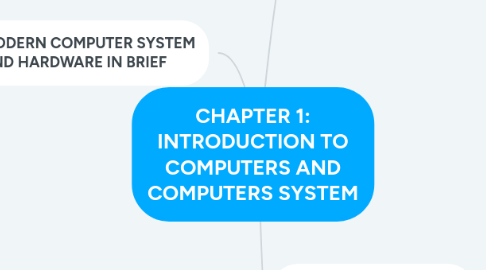
1. MODERN COMPUTER SYSTEM AND HARDWARE IN BRIEF
1.1. WHAT IS A CONPUTER?
1.1.1. Computer is an electronic device, operating under the control of instructions stored in its own memory.
1.1.2. Can accept data, process the data according to specified rules, produce results, store the results for future use.
1.1.3. A device that RECEIVES, STORES, and PROCESS informations.
1.2. Components of a Computer
1.2.1. HARDWARE + SOFTWARE = COMPUTER
1.2.2. Hardware - Devices that process data to create information.
1.2.3. Software - Step-by-steps instructions that tell computer how to do its work.
1.2.3.1. It is also called a program.
1.2.3.2. To convert data into a useful information.
1.3. Computer Hardware
1.3.1. Contains many electric, electronic, and mechanical components : HARDWARE
1.3.1.1. Input Device - Allows you to enter data and instructions into a computer.
1.3.1.2. Output Devices - Hardware components that conveys information to one or more people.
1.3.1.3. System Unit - Contains electronic components of the computer to process data.
1.3.1.4. Storage Devices - Records or retrieves items to form storage media.
1.3.1.5. Communications Devices - To send and receive data, instructions, and information from one or more computers or mobile devices.
1.4. Computer Software
1.4.1. A program that tells the computer what tasks to perform and how to perform them.
1.4.1.1. 1. System Software - Enables an application software to interact with computer hardware. (Operating system)
1.4.1.2. 2. Application Software - A program that performs a common task to the user. (Words / Excel)
1.5. Networks and the Internet
1.5.1. 1. Network - A collection of computers and devices connected together, wireless, via communications devices and transmission media.
1.5.2. 2. Internet - A worldwide collection of networks that connects millions of businesses, government agencies, educational institutions, and individuals.
1.6. Types of Computer
1.6.1. Supercomputers
1.6.1.1. The fastest, most powerful computer.
1.6.2. Mainframe Computers
1.6.2.1. Large, expensive, powerful computer that can handle hundreds or thousands of connected users simultaneously.
1.6.3. Midrange Computers
1.6.3.1. A computers with processing capabilities less powerful than a mainframe computer but more powerful than a personal computer.
1.6.4. Personal Computers
1.6.4.1. Perform all of its input, processing, output, and storage activities by itself.
2. BASIC COMPONENTS OF THE VON NEUMANN MACHINE
2.1. Input, Output, Processor, Storage, Memory
2.1.1. Memory - Short-term storage for CPU calculations, holds instructions & data of a computer program.
2.1.2. Input devices - keyboard, mouse, scanner
2.1.3. Output devices - monitor, printer, fax machines
2.1.4. Storage - hard disk, DVD, pendrives
2.2. Stored-Program Concept
2.2.1. John Von Neumann
2.2.2. Expert in physical science & mathematics, spoke many languages, and had a total recall of everything he heard, saw or read.
2.2.3. A consultant on ENIAC Program.
2.3. Von Neumann Architecture
2.3.1. Data & instructions are both stored in main memory while being stored.
2.3.2. Sequential processing of instructions.
2.3.3. Binary data processing.
2.3.4. CPU, Memory and I/O System
2.4. Central Processing Unit (CPU)
2.4.1. ALU - Arithmetic/logic Unit
2.4.1.1. Performs arithmetic and Boolean logical calculations.
2.4.2. CU - Control Unit
2.4.2.1. Controls processing of instructions.
2.4.2.2. Controls movement of data within the CPU.
2.4.3. IU - Interface Unit
2.4.3.1. Moves instructions and data between the CPU and other hardware components.
2.4.3.2. BUS - Bundle of wires that carry signals and power between different components.
3. HISTORY OF COMPUTERS
3.1. From 0 to the Latest Generations
3.1.1. 0th GENERATION - Mechanical Era
3.1.2. 1st GENERATION - Vaccum Tube
3.1.3. 2nd GENERATION - Transistor
3.1.4. 3rd GENERATION - Integrated Circuit Based
3.1.5. 4th GENERATION - Microprocessor
3.1.6. 5th GENERATION - Artificial Intelligence
